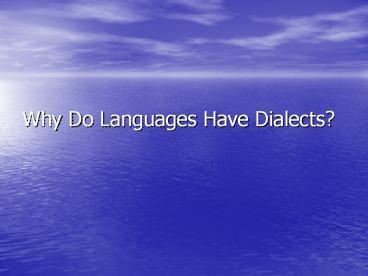Why Do Languages Have Dialects? - PowerPoint PPT Presentation
1 / 25
Title: Why Do Languages Have Dialects?
1
Why Do Languages Have Dialects?
2
Two kinds of explanations
- Sociohistorical the structure of society and the
characteristics of individual speakers language
as a kind of cultural behavior - (apparently external to language)
- Linguistic the structure of language as a system
- (apparently internal to language)
3
2.1 Sociohistorical Explanation
- Settlement patterns
- Migration routes
- Geographical factors
- Language contact
- Economic ecology
- Social stratification
- Social interaction, social practices, and speech
communities - Group and individual identity
4
2.1.1 Settlement
- Dialect differences from the British Isles
- Dialects from other areas (the Caribbean)
- Changes accompanying stages of settlement the
founder effect - (See maps on pp. 117 and 119)
5
(No Transcript)
6
2.1.2 Migration routes
- East-west fanning pattern of European
settlers---currently reflected in major highway
networks - Into the South through the Cumberland Gap
- South-North-South patterns of African-Americans
7
2.1.3 Geographical factors
- Rivers
- Factors contributing to isolation of groups
- IslandsGullah
- MountainsAppalachian speech
8
2.1.4 Language contact
- Native American languages
- European languages other than English French,
German, Spanish - Vocabulary items
- Morphology suffixes
- Syntax
9
2.1.5 Economic ecology
- Ecologically-based occupations farming,
fishing, coal-mining - Rural versus urban
10
2.1.6 Social stratification
- Social stratification is mirrored in language use
- Social stratification affects language change
- Social stratification appears to exist in even
the smallest communities
11
2.1.7 Social interaction, social practices, and
speech communities
- Patterns of transportation flow and population
movement - Social networks
- High density everybody knows everybody
- Multiplex interact with same people in different
arenas (school, home, work, church) - Low density everybody knows a particular
individual but they dont all interact with each
other - Uniplex a person interacts with different people
in each social arena (school, home, work, church)
12
Community of practice
- an aggregate of people who come together around
a common enterprise - and which is simultaneously defined by its
membership and the shared practices in which that
membership engages.
13
What the shift to community of practice
represents
- A focus away from pre-established structures
(whether small or large) - to ongoing social practices (through which
structures are maintained and changed) - which are dynamic and fluid rather than static
- in which individuals are active agents rather
than passive responders to situations or social
robots whose language use is determined by the
social categories to which they belong
14
speech community
- Labov a group of people with shared norms, or
common evaluations of linguistic variables - Start with social unit or with language variety?
- Defined from outside or inside?
- Issues of size and uniformity
- Partial solution a multilayered rather than a
unitary construct
15
2.1.8 Group and individual identity
- Projecting ones identity as a member of a
particular group by talking in a way associated
with that group - Changes across interactions
- Dilemmas of identity covert prestige
16
2.2 Linguistic Explanation
- Rule extension
- Analogy
- The transparency principle
- Grammaticalization
- Pronunciation phenomena
- Words and word meanings
17
Changes in English over time
- Old English (about 950 AD)
- Fader urer ðu bist in heofnas, sie gehalgad noma
ðin. - Middle English (about 1350 AD)
- Oure fadir Þat art in heuenes, halwid be Þi name.
- Early Modern English (about 1550 AD)
- O oure father which arte in heven, hallowed be
thy name. - Modern English (about 1985 AD)
- Our father who is in heaven, may your name be
sacred.
18
2.2.1 Rule extension
- Expansion of subject pronouns to object position
- Its me. versus It is I.
- Me and Charlie ate. versus Charlie and I ate.
- Intrusive r
- Park the car by the house/Park the car inside.
- The idear of it
- Cubar
19
2.2.2 Analogy
- Four-part or Proportional Analogy
- Typically irregular to regular pattern
- Cow cows ox oxes
- (Irregular older plurals oxen, deer, fish,
children) - Also minority pattern analogy
- Sing/sang/sung ----bring/brang/brung
- Leveling making a grammatically conditioned set
of forms more similar - I am, you are, s/he is, we are, you are, they are
- Leveled to I, you, s/he, we, you, they IS
20
2.2.3 Transparency and grammaticalization
- Transparency
- The need to make meanings as obvious as possible
- can vs. caint
- Redundancy multiple negation
- Aint nothin like em nowhere.
21
Grammaticalization
- a process whereby a new meaning becomes linked
to a particular grammatical structure - You all yall second person plural pronoun
in Southern Informal Standard - DOUBLE MODALS I might could go.
- New auxiliaries
- liketa (I was so cold, I liketa froze)
- fixin to (Its late, and Im fixin to go to
bed) - be (He always be coming to school late)
22
2.2.4 Pronunciation phenomena
- Articulation-related changes
- ASSIMILATION impossible, illogical, irregular
- WEAKENING bottle
- Dealing with consonant clusters
- Simplification (knee, sixths)
- Elimination by inserting vowels (athuhlete)see
metathesis on next slide
23
- Sound systems low back vowel merger---cot/caught
CHAIN SHIFTS (cf. Great Vowel Shift 1400-1600) - Sporadic changes metathesisbird, first ask/aks
- Syllable structure considerations (preference for
CVCVCV..) nuclear becomes nukular
24
2.2.5 Words and word meanings
- Soda/pop/cola/tonic/coke/soft drink
- Mommuck
- yonder
25
2.3 The Final Product
- The savory stew metaphor































